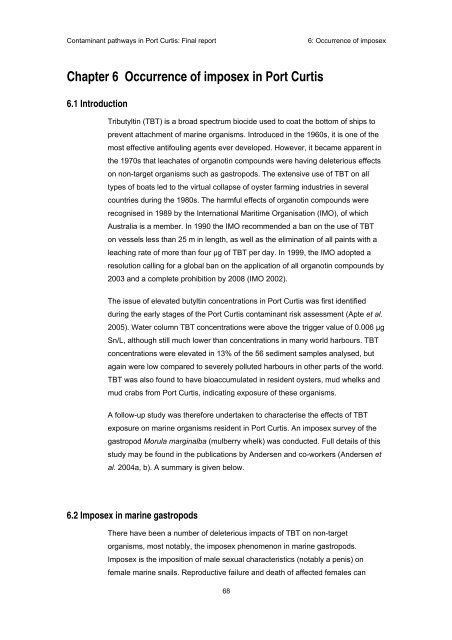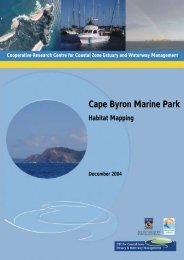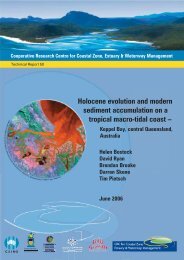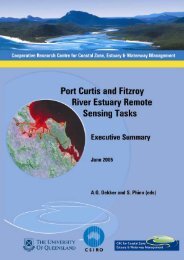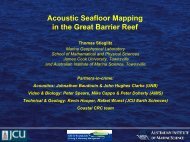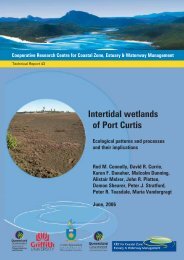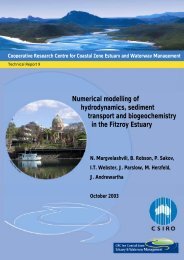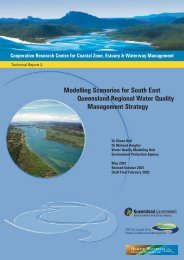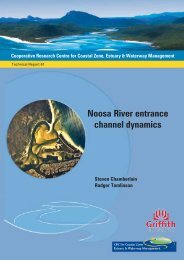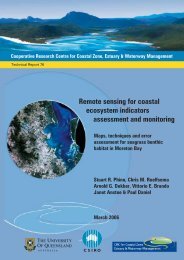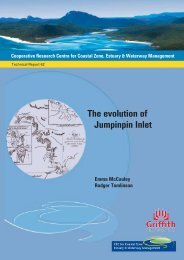Contaminant pathways in Port Curtis: Final report - OzCoasts
Contaminant pathways in Port Curtis: Final report - OzCoasts
Contaminant pathways in Port Curtis: Final report - OzCoasts
Create successful ePaper yourself
Turn your PDF publications into a flip-book with our unique Google optimized e-Paper software.
<strong>Contam<strong>in</strong>ant</strong> <strong>pathways</strong> <strong>in</strong> <strong>Port</strong> <strong>Curtis</strong>: F<strong>in</strong>al <strong>report</strong>6: Occurrence of imposexChapter 6 Occurrence of imposex <strong>in</strong> <strong>Port</strong> <strong>Curtis</strong>6.1 IntroductionTributylt<strong>in</strong> (TBT) is a broad spectrum biocide used to coat the bottom of ships toprevent attachment of mar<strong>in</strong>e organisms. Introduced <strong>in</strong> the 1960s, it is one of themost effective antifoul<strong>in</strong>g agents ever developed. However, it became apparent <strong>in</strong>the 1970s that leachates of organot<strong>in</strong> compounds were hav<strong>in</strong>g deleterious effectson non-target organisms such as gastropods. The extensive use of TBT on alltypes of boats led to the virtual collapse of oyster farm<strong>in</strong>g <strong>in</strong>dustries <strong>in</strong> severalcountries dur<strong>in</strong>g the 1980s. The harmful effects of organot<strong>in</strong> compounds wererecognised <strong>in</strong> 1989 by the International Maritime Organisation (IMO), of whichAustralia is a member. In 1990 the IMO recommended a ban on the use of TBTon vessels less than 25 m <strong>in</strong> length, as well as the elim<strong>in</strong>ation of all pa<strong>in</strong>ts with aleach<strong>in</strong>g rate of more than four µg of TBT per day. In 1999, the IMO adopted aresolution call<strong>in</strong>g for a global ban on the application of all organot<strong>in</strong> compounds by2003 and a complete prohibition by 2008 (IMO 2002).The issue of elevated butylt<strong>in</strong> concentrations <strong>in</strong> <strong>Port</strong> <strong>Curtis</strong> was first identifieddur<strong>in</strong>g the early stages of the <strong>Port</strong> <strong>Curtis</strong> contam<strong>in</strong>ant risk assessment (Apte et al.2005). Water column TBT concentrations were above the trigger value of 0.006 µgSn/L, although still much lower than concentrations <strong>in</strong> many world harbours. TBTconcentrations were elevated <strong>in</strong> 13% of the 56 sediment samples analysed, butaga<strong>in</strong> were low compared to severely polluted harbours <strong>in</strong> other parts of the world.TBT was also found to have bioaccumulated <strong>in</strong> resident oysters, mud whelks andmud crabs from <strong>Port</strong> <strong>Curtis</strong>, <strong>in</strong>dicat<strong>in</strong>g exposure of these organisms.A follow-up study was therefore undertaken to characterise the effects of TBTexposure on mar<strong>in</strong>e organisms resident <strong>in</strong> <strong>Port</strong> <strong>Curtis</strong>. An imposex survey of thegastropod Morula marg<strong>in</strong>alba (mulberry whelk) was conducted. Full details of thisstudy may be found <strong>in</strong> the publications by Andersen and co-workers (Andersen etal. 2004a, b). A summary is given below.6.2 Imposex <strong>in</strong> mar<strong>in</strong>e gastropodsThere have been a number of deleterious impacts of TBT on non-targetorganisms, most notably, the imposex phenomenon <strong>in</strong> mar<strong>in</strong>e gastropods.Imposex is the imposition of male sexual characteristics (notably a penis) onfemale mar<strong>in</strong>e snails. Reproductive failure and death of affected females can68


